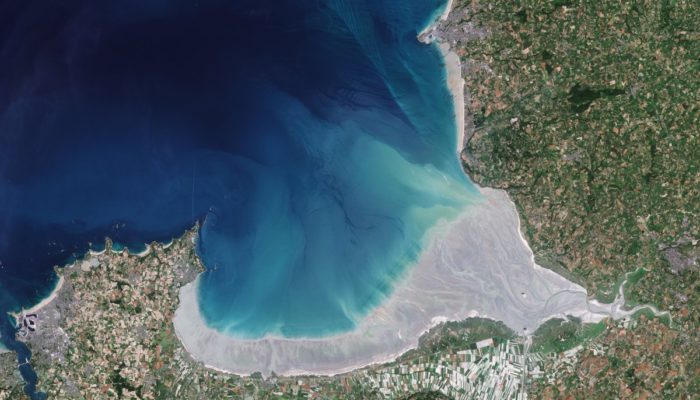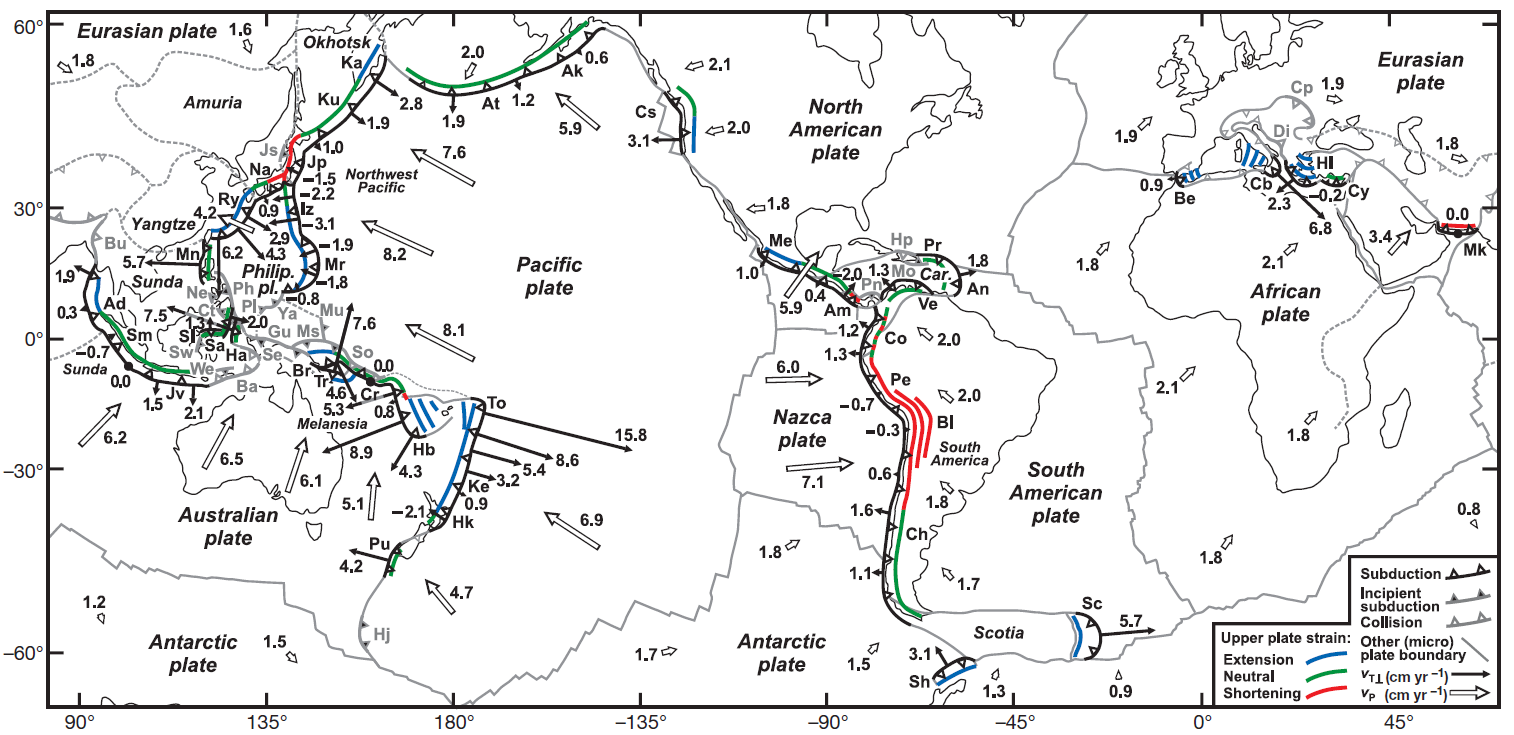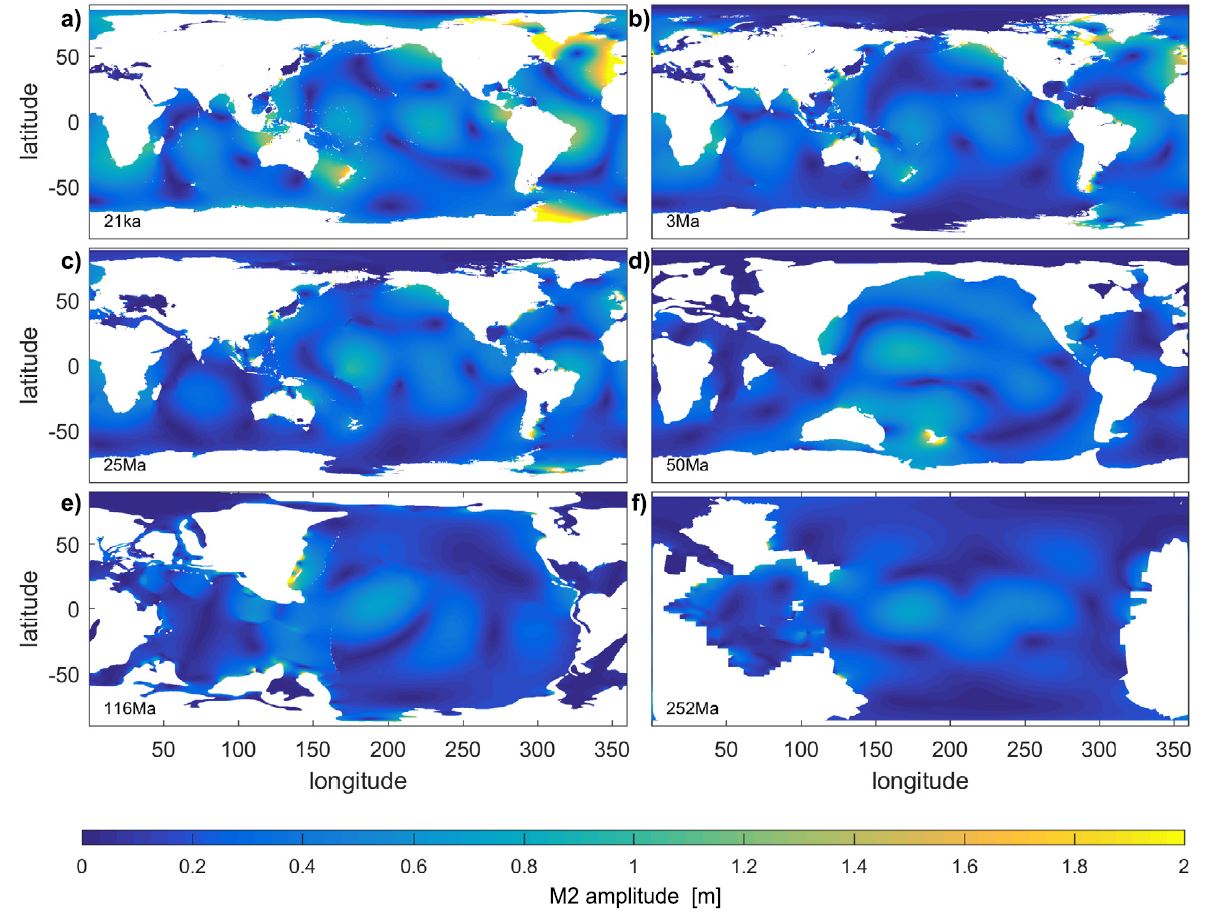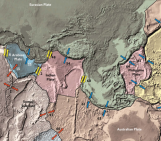
“Beyond tectonics” is a blog series which aims to highlight the connections between tectonics and other aspects of the Earth system. In this iteration of the “Beyond tectonics” series we talk about how plate tectonics have affected the tides on Earth over geological timescales. We will talk about tectonics on the Earth since the formation of Pangea to the present day, and into the future, ending with the formation of the next Supercontinent in around 200 – 250 Million years from now.
Tides of the Planet Earth
The Earth’s tides are predominantly caused by the gravitational pull of the Moon, and the centripetal force of the Earth due to its rotation. The force of the Moon and the spin of the Earth cause two tidal bulges to form, one that follows the Moon, and one on the opposite side of the planet. These two tidal bulges move around the Earth with a period of 12.5 hours. When the buldge moves over a coast, a high tide occurs, and when a bulge is not over a coast, a low tide occurs. This is why there are two low and high tides each day. These tides vary in strength around the world because ocean and coastal morphology plays a large role in how the tidal energy is distributed.
How do tectonic plates affect the tide?
The surface of the Earth is broken up into pieces like the shell of an egg. These pieces, or plates, can be divided into oceanic and continental plate. The main difference between the two types of plate is their buoyancy. Both types of plate are buoyant, however, after it is formed at a mid ocean ridge, ocean plate becomes less and less buoyant with age. Eventually, after around 30 million years, ocean plate is less buoyant than the underlying mantle meaning it could sink if it reached a subduction zone. In the present-day oceans, almost all plate older than 180 million years old has sank back into the mantle at a subduction zone. This recycling of ocean crust is what causes the oceans to change shape. The continents are pulled together by the closing oceans (sinking ocean plate), and pushed apart by the opening ones (creation of ocean plate). In the present day, the Pacific is closing and the Atlantic is opening, causing the plate drift map to look like this:

The major subduction zones on Earth. Black arrows illustrate trench migration vectors, while open arrows illustrate plate velocity (credit – Schellart et al., 2007)
As the oceans grow and shrink, their width changes. This means the tidal wave in those oceans has either too little, too much, or just the right amount of space to flow in the ocean. In the present-day the Pacific is too big, the Indian ocean too small, but the Atlantic ocean is just the right size to make the tide resonant.
What is resonance?
To explain resonance, imagine the tidal wave moving across the Atlantic ocean and back, like a child on a swing. If you apply the force on the swing when it is at the highest point, you are applying a force at one of the natural frequencies of the system, so the energy you input will make the swing go higher. If you push the swing before or after it reaches its peak, then you might input some energy, but it won’t be as efficient. The Atlantic ocean is just the right width to allow the wave to “swing” back and forth. The input of energy is applied at just the right point, one of the natural frequencies of the tide, to allow resonance.
It is possible for this to happen in any ocean basin. An ocean basin can house resonant tides when the width of the basin (L) is equal to a multiple of half wavelengths of the tide (𝜆 = √gHT), where (T) is the tidal period, (g) is gravity, and (H) is water depth. Essentially, when the ocean basin has a width that intersects with a natural frequency of the tide, it will become resonant.
The Super-tidal cycle
The reason why the present day tides are the biggest since the formation of Pangea is because the Atlantic is currently resonant with the tide, i.e. it is in a Super-tidal period. Looking at the energy of the tides from when Pangea existed to the present-day (Green et al., 2017), we can see that during Pangea’s life the tides were weak. That status quo continued from 180 to 1 million years ago, when the Atlantic suddenly developed large tides. The Atlantic had been growing all that time, and had finally reached a width where the tide became resonant.

M2 tidal amplitudes since the breakup of Pangea (credit – Green et al., 2017)
The large present-day Atlantic tide is unlikely to last. Green et al., (2018) predict that this super-tidal period will last around 20 million years, and Davies et al., (2019) predict another won’t occur for tens of millions of years, depending on how the future Earth develops.
Therefore, what are the implications of the present-day Atlantic having such large tides? Further testing of the implications of the Super-tidal cycle is needed before any conclusions can be made on how it may affect the Earth system. However, the larger energy input into the oceans during a Super-tidal period may enhance tidal mixing, which means the ocean will have a better distribution of nutrients and oxygen, i.e. it is less likely for it to become stratified. What we do know right now, is that Supercontinents generally have very weak tides (Green et al., 2018), and periods of continent divergence similar to the present day, have larger, or sometimes Super-tides (Balbus 2014; Davies et al., 2019).
References
- Balbus, S. A. 2014, Dynamical, biological and anthropic consequences of equal lunar and solar angular radii. Proc. R. Soc. A, 470. Available at: http://doi.org/10.1098/rspa.2014.0263
- Davies, H. S., Green, J. A. M., Duarte, J. C., 2018, Back to the future: testing different scenarios for the next supercontinent gathering. Global and planetary change, 169, 133 – 144. Available at: https://doi.org/10.1016/j.gloplacha.2018.07.015
- Davies, H. S., Green, J. A. M., Duarte, J. C., 2019. Back to the future 2: Tidal modelling of four potential scenarios for the next Supercontinent gathering. Presented at EGU 2019. Available at: https://meetingorganizer.copernicus.org/EGU2019/EGU2019-1004-1.pdf
- Green, J.A.M., Molloy, J.L., Davies, H.S., Duarte, J.C., 2018. Is there a tectonically driven super-tidal cycle? Geophys. Res. Lett. 45 (8). Available at: https://doi.org/10.1002/2017GL076695.
- Schellart, W.P., Freeman, J., Stegman, D.R., Moresi, L., May, D. 2007. Evolution and diversity of subduction zones controlled by slab width. Letters to Nature, 446, 308 – 311. Available at: doi:10.1038/nature05615




Domingo
Intersting article. Another aspect of how Earth appears to be presently optimized for life.
However, I think that the Earth’s spin does not contribute to the tides because the centrifugal force does not vary along the same latitude. It’s rather the rotation of the Earth about the centre of gravity of the Earth-Moon system (situated at some depth below the Earth’s surface) that creates an asymmetric centripetal force that balances the Moon’s pull and causes the second bulge on the opposite side of the Earth (facing away from the moon).
Hannah Davies
Thank you for your comment, I wanted to simplify the explanation of the tidal bulges to keep it from taking up too much space, however thank you for the clarification of the method, I may use your explanation in the future as it is quite eloquent. I am glad you enjoyed the article.